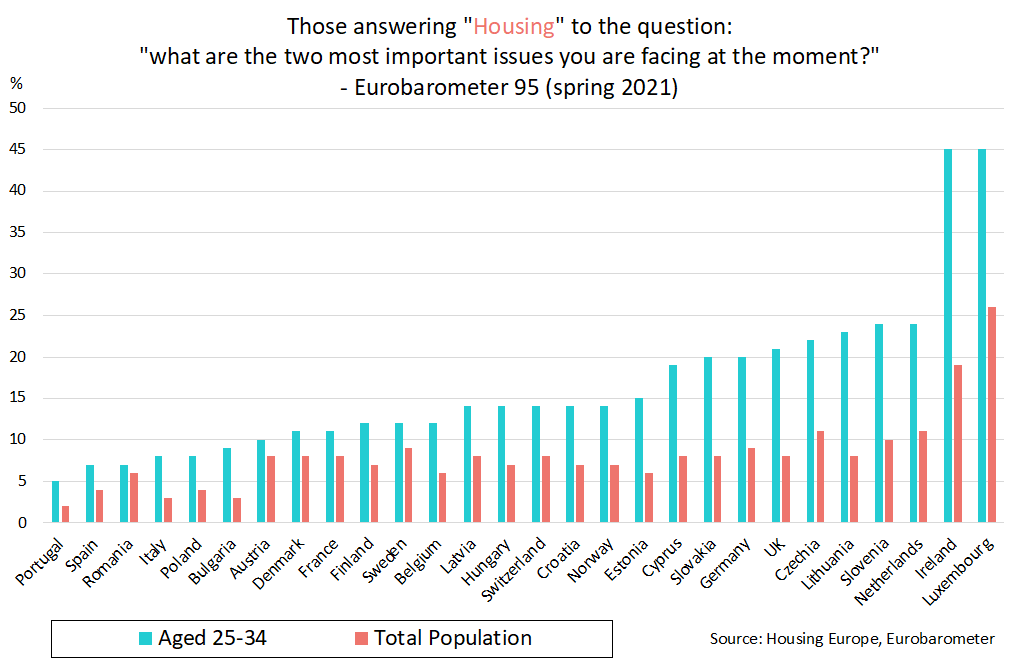“But if we are to shape our Union in their mould, young people must be able to shape Europe’s future. Our Union needs a soul and a vision they can connect to. Or as Jacques Delors asked: How can we ever build Europe if young people do not see it as a collective project and a vision of their own future?” This is how European Commission’s President, Ursula von der Leyen officially announced that 2022 will be the European Year of Youth during her annual most important speech about the State of the EU. Already a quarter of the way into this special year, we see the EU’s ambition to make young peoples’ lives greener, more inclusive, and more connected. However, where is housing in this picture?
Housing is arguably the most fundamental building block upon which young adults base their early independence. Being handed the keys to your first place to live as an independent adult is a feeling like no other. At the same time, for many young people in Europe access to a home of their own also means being able to access vital education or training opportunities, as well as greater access to employment. This is particularly the case for young people who grow up outside of the main metropolitan hubs of their country, where educational and employment opportunities tend to be concentrated.
However, as is increasingly becoming the case, young people are struggling to access housing in many parts of Europe. While this limits their chances for personal and social progression, it can also lead to the creation of so-called ‘insider’ versus ‘outsider’ issues. This means that young people who already live in cities (the ‘insiders’) have a natural advantage over those who need to move to their city (the ‘outsiders’). This can widen social and spatial inequalities.
The most recent Eurobarometer survey shows that housing is a major concern for young people in Europe today. For example, over 20 per cent of those aged 25-34 stated “housing” was one of the two main issues facing them personally in Germany, the United Kingdom, the Netherlands, Czechia, Slovakia, Ireland, Lithuania, Slovenia, Luxembourg and Cyprus. In the cases of Ireland and Luxembourg, 45 per cent of respondents named it as a top issue.
At the same time, the Eurobarometer data show often large differences in housing related concerns between different parts of a country. For example, in the German context, 24 per cent of those in Berlin (regardless of age) listed housing as a top concern, versus only 9 per cent of the country as a whole. The gap between students and the general population is also often stark. In France, 24 per cent of current students list housing as a major concern, compared to only 8 per cent of the general population.
Issues around the access to education should be of particular concern for national governments. Indeed, frequent studies show the importance of higher education on promoting greater social mobility and equality. A recent OECD report noted that given “the increasing importance of tertiary education for skills needed in the labour market and for earnings, a lack of access to higher education can have negative consequences for longer-run earnings trajectories and for social mobility”.
The role played by providers of public, cooperative and social housing in terms of promoting access to affordable housing for young people differs quite a lot between member states. For example, the most recent round of Eurofound’s European Quality of Life Survey showed that at least a quarter of those aged 18-34 in the UK, Netherlands, France and Austria lived in some form of non-profit housing. At the other end of the spectrum, in countries where there is little or no social housing provision like Cyprus, Greece, Croatia and Hungary, the numbers of young people in non-profit housing were negligible.
If we zoom in for a moment on some examples of good practices from the public, cooperative and social sector. In France, where around a quarter of young people live in social housing, housing providers increasingly offer solutions together with their partners such as local youth organisations. Besides ‘classic’ social rental housing – which is open to households of all ages, without any specific priority for youth – there are also dedicated youth options. These include shared housing (for those up to the age of 30) through associations/registered organisations working with young people, social residences for young workers, and social university residences for students and people below the age of 30, who are currently in training/stage.
In Denmark, non-profit housing providers, which provide 20% of all homes in the country, provide special ‘youth’ housing. Youth housing must be rented out to young people pursuing further education or young people with a particular need for it. This practice is crucial in supporting young people to access affordable homes while they pursue their education and training. It is a contributing factor in the fact that the average age at which a young person leaves their family home in Denmark is just 21.2 years old, versus the EU average of 26.4 years.
In Slovenia, the Housing Fund of the Republic of Slovenia (HFRS), is responsible for providing long-term financing for the development of affordable housing. It also directly develops social housing to meet specific social functions. This includes housing aimed at young people (aged 18-29), who may otherwise struggle to live independently, or access education or employment opportunities. As well as providing affordable and secure housing, the HFRS schemes for young people try to include complimentary amenities, such as on-site co-working facilities.
Finally, we also see efforts from the cooperative housing sector to help and provide housing specifically aimed at young people. For example, in Sweden members of the Riksbyggen housing cooperative network have developed a scheme to provide housing to those aged 18 to 30. The cooperative homes will help those who are unable to live in urban centres, despite having stable jobs and incomes, as a result of on-going supply and affordability issues in Sweden. Another interesting element of the initiative is that the housing will be developed in cooperation with the young people themselves. When the homes are finished, the future residents will buy a share in the cooperative (that will have to be sold back to the cooperative if they decide to move out) and pay a monthly rent.
While these initiatives, and others like them[i], are of real value to many young people in Europe today, they are clearly not sufficient in terms of scale or geographic reach to achieve the goal of housing inclusion and affordability for all young people. All things considered, current best practices from around Europe may point the way for policymakers to help increase the availability of much needed housing for the youth of our continent. For example, policymakers could consider:
- Investing in building affordable housing, which can help to deal with shortages that disproportionally impact on young people, especially in high-demand urban areas
- Housing providers in partnership with local authorities should analyse the needs at local level and identify the gaps in the existing housing stock – typically for instance lack of small sized apartments and student accommodation
- On the private rental market, quality of the homes and security of tenure should be guaranteed, as well as some form of control on rent levels to ensure rent is affordable
- For young people on low incomes an ‘independence-supporting approach’ is needed including rent deposit guarantee schemes, and access to housing allowances
- As home ownership becomes more difficult for young people to achieve, cooperative housing, Community Land Trust and other collaborative initiatives can provide a good step on the ‘housing ladder’ that is both affordable and collectively owned and managed
- Encourage involvement of youth in the local community, support their own initiatives and creativity. Encourage youth to give their opinion and participate also in other ways for instance through on-line platforms and social media
- Empower youth by providing access to financial counselling, training, volunteering opportunities and job placements
- Implement measures to combat and prevent youth homelessness, developed with people who are directly concerned, and focus on housing first through social housing with support
- New neighbourhoods and major urban regeneration projects should keep in mind the preferences and aspirations of today’s youth, who will be tomorrow’s owners and tenants. These preferences are likely to put a stronger emphasis on sustainable living, including a reduced role for cars and greater allowances for shared spaces.
The European Union and individual nations can help to achieve these objectives, including by:
- Recognising and supporting an increased role for public, not-for-profit and cooperative housing providers in ensuring supply of affordable housing for youth and students
- Reviewing the link between housing and education, the impact of housing affordability on levels of educational attainment at all educational levels.
- Consider the link between the availability of affordable housing, mobility and access to jobs
- Investing in social inclusion of youth including measures such as the provision of long-term housing, related social & care services, as well as training & education
[i] See our recent publication for more examples of innovate youth housing interventions from Housing Europe members: https://www.housingeurope.eu/resource-1081/housing-the-eu-youth

